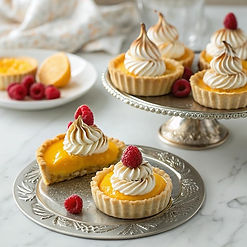Swiss Meringue Stability for Decorative Piping Applications

Prue Leith's praise "creamy meringue" combined with Jasmine's elegant presentation of piped rosettes creating height and texture demonstrates advantages of Swiss meringue over French method for applications requiring structural stability and smooth piping consistency.
The Swiss technique (heating egg whites with sugar to 160°F before beating) solves multiple problems, simultaneously: pasteurizing eggs for food safety, allowing uncooked meringue consumption, dissolving sugar completely (preventing grainy texture that French meringue risks when sugar doesn't fully incorporate), and denaturing proteins more thoroughly creating denser more stable foam that pipes cleanly and holds decorative shapes through torching.
The "smooth when rubbed between fingers" test confirms complete sugar dissolution where gritty feeling indicates need for continued heating, making tactile assessment more reliable than visual cues for determining readiness to begin beating.
Beating on high speed until stiff glossy peaks form and bowl is cool to touch (about 7-10 minutes) creates dense stable foam through mechanical incorporation of air into heat-denatured proteins, where French meringue's room-temperature beating produces lighter less stable result appropriate for folding into batters but unsuitable for structural piping.
The large star tip piping creates defined ridges and valleys in rosette pattern that catch light beautifully when torched producing golden peaks while valleys remain white, demonstrating how piping technique affects visual impact beyond just flavor or texture. The height and texture Jasmine achieved signals confidence and skill where timid low swirls communicate hesitation while bold tall rosettes demonstrate mastery, making presentation reflect technical ability before judges taste confirming that appearance communicates competence.
The torch browning selectively caramelizes sugar on exposed surfaces creating Maillard reaction complexity and visual contrast while leaving inner meringue white and creamy, proving that finishing technique adds both flavor dimension through caramelization and textural variation through crispy-outside creamy-inside contrast. This Swiss meringue advantage extends to all decorative applications: topping pies with stable peaks that don't weep, creating baked Alaska swirls that hold through blowtorching, piping meringue cookies that maintain definition during baking, or constructing pavlova nests with structural integrity, proving that understanding different meringue methods and selecting appropriately for application prevents common failures where French meringue collapses or Italian meringue's hot syrup intimidates, making Swiss method optimal middle ground for home bakers seeking professional results in decorative piping situations Jasmine demonstrated earning absolutely perfect assessment and rare handshake.


